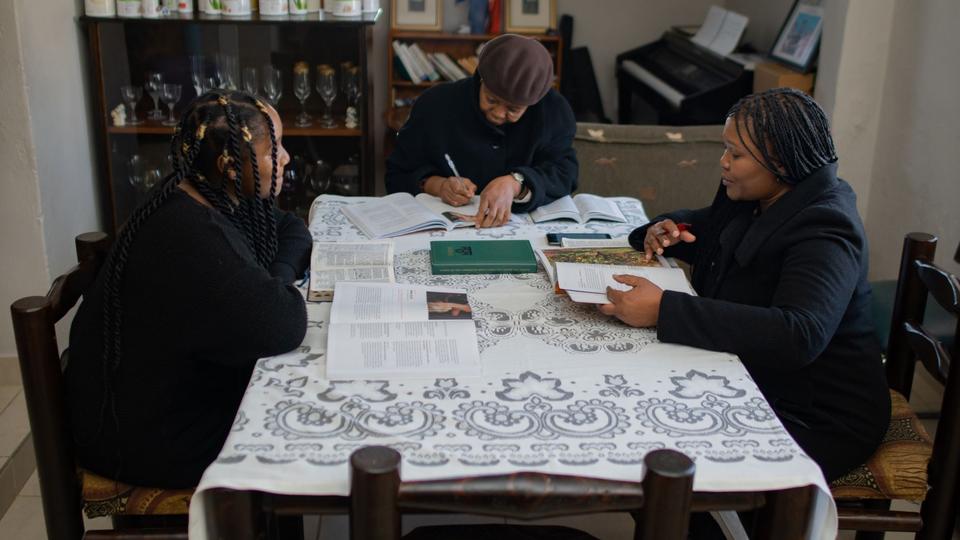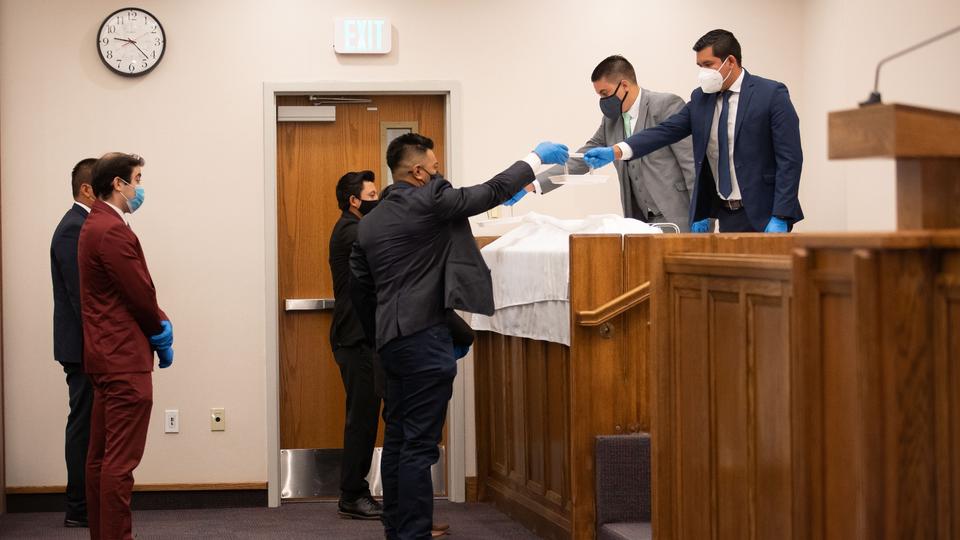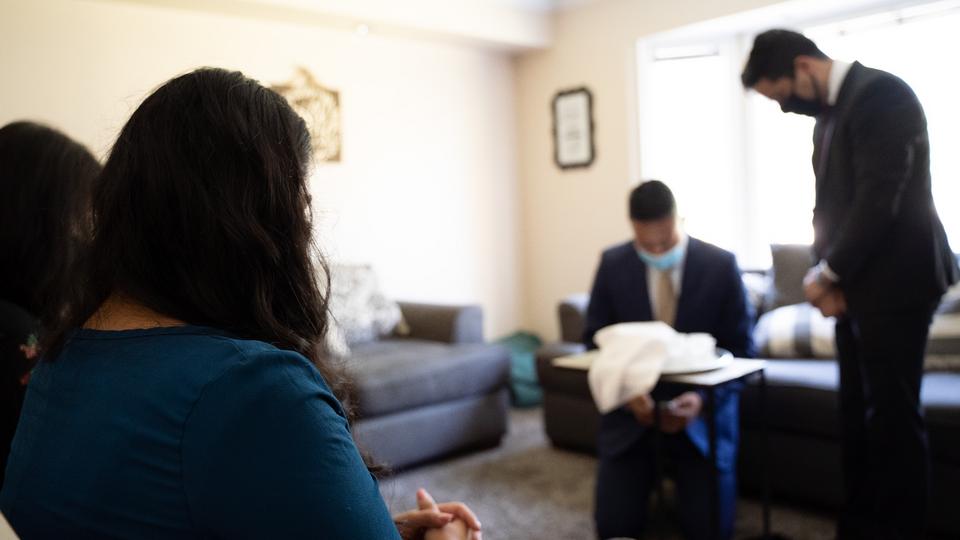(For Non-Muslims’ Use Only)
Some 2,100 years ago, a holy man taught a beleaguered people in the Western Hemisphere that worshipping God is not an act confined to a church building.
“Do ye suppose that ye cannot worship God save it be in your synagogues only?” the Book of Mormon prophet Alma asked a group of outcasts whose religious freedoms had been severely restricted. “If ye suppose that ye cannot worship God, ye do greatly err, and ye ought to search the scriptures; if ye suppose that they have taught you this, ye do not understand them” (Alma 32:10; 33:2).
Worship, Alma said, can take place in the wilderness, the plowing field, the home, one’s private closet or a person’s regular congregation — in sum, virtually anywhere.
The timeless elasticity of this teaching on the geographic parameters of proper worship of God has been on full display in the Latter-day Saint world since March 2020. That is when The Church of Jesus Christ of Latter-day Saints, along with the rest of the world, began adapting to the challenging global environment brought about by COVID-19.
-
- Worship 5
- Washington DC Church Worship
- New Zealand Sacrament Meeting
- Worship 13 Lemus family Belize
- New Zealand Sacrament Meeting
- Washington DC Church Worship
- Frankfurt Germany Sacrament Meeting
- Worship 2
- South Africa Home Church Worship
- Worship 1 Taylorsville
- Washington DC Church Worship
- South Africa Home Church Worship
- Washington DC Church Worship
- New Zealand Sacrament Meeting
- South Africa Home Church Worship
- Worship 7
- New Zealand Sacrament Meeting
- South Africa Home Church Worship
- Washington DC Church Worship
- New Zealand Sacrament Meeting
- New Zealand Sacrament Meeting
- New Zealand Sacrament Meeting
- Worship 10 Taylorsville
- Washington DC Church Worship
- New Zealand Sacrament Meeting
- South Africa Home Church Worship
- Worship 3
- fam-POOU-CHIQUIN-3.jpeg
- Worship 8
- Worship 6
- Washington DC Church Worship
- Worship 4
- Washington DC Church Worship
- Worship 12 - Guatemala Miranda Rivera Family
- Worship 9 Taylorsville
| Temple Square is always beautiful in the springtime. Gardeners work to prepare the ground for General Conference. © 2012 Intellectual Reserve, Inc. All rights reserved. | 1 / 2 |
Like many other people of faith, Latter-day Saints in normal times gather at their local chapels for weekly worship. For most Church members, this happens on Sundays. Following the pattern established in scripture, this involves the administration of the sacrament of the Lord’s Supper. Bread and water, symbols of the body and blood of Jesus Christ, are distributed by members of the priesthood to each congregant, one by one. This sacrament meeting is followed by a second hour of worship that focuses on learning the gospel of Jesus Christ.
This pattern came to a halt on March 12, 2020, when the First Presidency and the Quorum of the Twelve Apostles temporarily suspended public gatherings of Latter-day Saints around the world.
Experiencing the Fruits of Home-Centered Worship
Although face-to-face group worship opportunities are optimal, the Church’s lay ministry has allowed Latter-day Saints to continue to feel close to God and to their local faith networks. Men can enter the priesthood when they are 11, and young men who are at least 16 can administer the sacrament. Thus, if circumstances require it and Church leaders allow it, fathers and sons can perform this function in their homes, as has been the case during COVID-19. Members of the priesthood have extended this blessing to others in their congregational boundaries who do not have priesthood members in their homes.
“With me as a single mother, with no priesthood holder in the family, it has been a challenge because we haven’t had the sacrament [as often],” says Lizzie Mohodisa of South Africa. “But once in a while, our ministering brethren are able to come. It’s not every week as we have always been used to. But it is still a huge blessing.”

South Africa Home Church Worship
A family in Johannesburg, South Africa, gathers for Sabbath Day worship to discuss the “Come, Follow Me” curriculum, July 19, 2020.2020 by Intellectual Reserve, Inc. All rights reserved.David Soto, a member of a young single adult Spanish-speaking congregation in Utah, has administered the sacrament to women in his ward who do not have members of the priesthood in their homes. He describes this as a humbling privilege.
“I feel it’s an honor for me to hold the priesthood and be able to serve people,” Soto says. “Especially with the sacrament — it’s a time where they can connect with their Savior, where they can feel closer to Him. And me being able to bring that in my own humble way is something I couldn’t describe fully in words.”
And just as President Russell M. Nelson said in March, many Saints are finding that these disruptions to routines are providing “additional time to experience how precious home-centered gospel study can be.” Several have described the blossoming bonds of familial love and unity that have come from spending ample amounts of time together.
“During this historic pandemic and worldwide paralyzation, our home has become our refuge, our holy place, our center of worship,” says Benjamin Poóu Chiquin, a father of five in Guatemala.
Jade Reiri of New Zealand says, “It was a really great opportunity for our kids to be able to see their dad and their older brother bless the sacrament right in front of them, and to see what happens, and bring it all home.”
Most importantly, says Diane Taim of South Africa, is the spirit that has surrounded her family as they have converted their home into a church.
“Initially you have these huge cups and it all looks different,” says the mother of four (the Church’s small sacrament cups fit roughly a tablespoon of water). “But I felt the Savior so close. And I felt He is very aware of what we are doing. Something that can be commonplace and fairly automatic … has felt incredibly sacred.”
“It doesn’t feel like we haven’t been to church this week because we’ve been able to worship, we’ve been able to have the sacrament,” added her husband, Olev. “I think it’s just a miracle that the Lord has enabled us to be able to follow this plan and have the sacrament, have a meeting, have the Spirit. It’s been a good experience.”

South Africa Home Church Worship
The Taim family in Johannesburg, South Africa gathers to observe the Sabbath Day in their home and to video chat with extended members of their family to discuss the "Come, Follow Me" curriculum, July 19, 2020. 2020 by Intellectual Reserve, Inc. All rights reserved.That feeling knows no borders. Eight thousand miles away from South Africa, in Washington, D.C., Rosemary Demos says it does not matter “where I’m taking [the sacrament], whether I’m in a church building or a home — as long as I can feel that spirit and feel the sacredness of the ordinance.”
Another important enabler of a richer home-centered worship experience is the home-centered curriculum President Nelson introduced at the October 2018 general conference.
“We are blessed that we have the prophet, who is called of God,” Mohodisa says. “The programs that were put in place [in January 2019] were in a way, now that we look back, preparing us for this period. Now we can manage to do home-based sessions without a problem.”
A Cautious Return to the Chapel
In May, as allowed by local conditions and government regulations, the Church began a careful, cautious return to weekly worship in its meetinghouses. The importance of gathering as a religious body was mentioned in revelations before the Church was formally organized in 1830. And as Elder David A. Bednar told scholars and legal professionals in June 2020, “a central mission of the Church is to gather together the scattered family of Abraham — and indeed all who are willing — to the ordinances and covenants of the Savior’s gospel. Through that gathering, we believe God will establish a people who are of one heart and one mind, who dwell together in righteousness and peace, and who love and care for each other so completely that no poor, spiritually or physically, are found among them.”
Gathering, the Apostle added, is central to all faith and religion. “Indeed, if the faithful are not gathering, sooner or later they will begin to scatter,” he said.

Worship 8
Priesthood holders in Taylorsville, Utah, wear face masks and plastic gloves while passing sacrament trays to fellow Latter-day Saints during the sacrament meeting on Sunday, August 16, 2020. Worship services for Latter-day Saints around the world have either been canceled or adjusted to closely follow the guidance of governments and Church leaders to prevent the spread of the pandemic. 2020 by Intellectual Reserve, Inc. All rights reserved.For many Latter-day Saints, the return to communal worship has been the breath of fresh air it is envisioned as being in scripture. Joann Montesinos of a young adult Spanish-speaking ward in Utah says this is especially true in the Latino culture, where community is a “really, really big deal.”
“Going without [weekly worship] for three, four months was really hard on us as a ward and just as a people in general,” Montesinos says. “Even though we can’t really get together the way that we used to [because of ongoing precautions], just being able to have the support once again of your ward family — especially for those who have come [to Utah] and they’re by themselves. They don’t have their families; they’re starting over again. To be able to have that support once again in the church has been a beautiful, beautiful thing.”
Two thousand miles to the east, Vivian Olsen of Washington, D.C., shared similar thoughts.
“It is so moving to see our community again in person. I love the ward members so much,” Olsen says. “I don’t miss any of the Zoom meetings. It’s my husband and me at home now. We really love our sacrament time. We always want to meet with the members and feel of their spirit and feel the community we have spent so many years enjoying and building together.”
Jeff Cuff of New Zealand has also delighted in the energy and warmth of returning to in-person worship with his fellow Saints in the Pacific. “One of the main reasons the Church was established was so that the Saints could meet together oft and to fellowship together,” he says. “To feel the spirit and the testimony of the other Saints is a wonderful thing to come back to.”
As good, healthy and important as fellowship is, the Saints are remembering that the central purpose of their Sabbath worship is the sacrament of the Lord’s Supper.
This time is special, Eduardo Sanz Garcia of Frankfurt, Germany, says, because “it is the highlight of my week. I look forward to this moment in which I can really feel close to the Savior.”
Ms. Demos of Washington, D.C., added that she loves that the ceremony of the sacrament is “just what Christ did back when he had the Last Supper. … I feel like of all the moments in the sacrament meeting, between the talks and the music, that’s the moment where I feel closest to Christ.”
Fittingly, such a focus on the Savior of the world was the essence of the preaching of the holy man Alma to the downtrodden Zoramites mentioned at the beginning of this article. Though he knew the physical location of worship was not essential, he left no doubt that the object of worship certainly was.
“Believe in the Son of God,” Alma pleaded. “May God grant unto you that your burdens may be light, through the joy of his Son.”
Whether at home or the chapel, in times of peace or pandemic, that is what you will find many Latter-day Saints around the world pursuing and proclaiming each Sabbath day.
